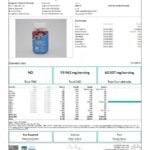
Data-Driven Strategies for Successful Weed Businesses
- Understanding the Power of Data in Weed Businesses
- Collecting and Analyzing Market Data
- Enhancing Cultivation and Production
- Inventory Management and Demand Forecasting
- Personalization and Customer Engagement
- Compliance and Regulatory Reporting
- Pricing Strategies Informed by Data
- Supply Chain Optimization
- Financial Analysis and Performance Tracking
- Staying Ahead with Predictive Analytics
- Conclusion
In the rapidly evolving cannabis industry, data-driven approaches have become instrumental in achieving success for weed businesses. This content aims to provide a comprehensive guide on leveraging data for informed decision-making and optimizing operations in the cannabis market.
This post is intended as information and for general knowledge only. It is not a substitute for medical advice, diagnosis, or treatment. It is recommended that you talk to a healthcare professional about this before introducing cannabinoids into your daily routine (especially if you have been diagnosed with any medical conditions or are under any medication). It is not recommended to drive or operate any machinery when using cannabis- or hemp-derived products. Use responsibly!
Understanding the Power of Data in Weed Businesses
Importance of Data-Driven Strategies
In the dynamic landscape of the cannabis industry, where legal cannabis and recreational marijuana have gained traction, data-driven decisions have proven to enhance competitiveness and foster growth. Savvy cannabis businesses are recognizing the potential of data to transform their operations and drive success.
Examples of successful companies using data-driven approaches in the cannabis industry abound. From cannabis retailers using inventory data and sales data analytics to improve supply chain efficiency to cannabis brands harnessing customer data for targeted ads, the benefits of data utilization are evident.
Benefits of Utilizing Data
In the cannabis space, having a grasp of data analytics translates into improved market insights and a better understanding of cannabis consumers’ behaviors. This insight, in turn, leads to enhanced operational efficiency and more strategic resource allocation. Moreover, data enables cannabis businesses to predict demand more accurately, thus optimizing their supply chain management.
Key Data Sources for Weed Businesses
To establish a data-driven foundation, businesses can rely on diverse data sources. Market research reports, industry publications, and trend analysis are essential for understanding the competitive landscape. Collecting customer feedback and behavior data from online platforms and point-of-sale systems provides actionable insights for marketing strategies. Cultivation data derived from IoT sensors, climate control systems, and monitoring tools is pivotal for cultivators, optimizing plant health and yield.
Collecting and Analyzing Market Data
Identifying Relevant Market Data
To steer their cannabis business, companies must first define their target demographics and market segments. Collecting data on consumer preferences, purchasing patterns, and regional trends empowers businesses to tailor their offerings more effectively.
Implementing Competitive Analysis
Competitor analysis forms a cornerstone of data-driven strategies in the cannabis industry. By delving into competitors’ product offerings, pricing strategies, and customer engagement, businesses can identify gaps in the market and carve out unique selling propositions.
Leveraging Data for Opportunity Identification
With data insights, businesses can proactively recognize emerging trends and evolving product demand. This empowers them to create cannabis products that cater to underserved niches, resulting in higher customer satisfaction and increased sales.
Enhancing Cultivation and Production
Data-Driven Cultivation Techniques

Cultivators in the cannabis industry are increasingly using data to refine their cultivation processes. By monitoring and controlling environmental factors like temperature, humidity, and lighting, data-driven cultivation techniques optimize plant growth and maximize yield.
IoT and Sensor Integration
The integration of IoT devices and sensors is revolutionizing cannabis cultivation. Real-time data collection through these devices allows for precision in irrigation, nutrient delivery, and pest management, leading to healthier plants and better yields.
Refining Production Strategies
Data analysis not only enhances cultivation but also helps refine broader production strategies. By examining data, businesses can identify areas for process improvement and resource optimization, leading to increased operational efficiency.
Inventory Management and Demand Forecasting
Utilizing Historical Sales Data
The past can provide valuable insights for the future. By analyzing historical sales data, businesses can predict demand patterns and seasonal fluctuations. This foresight aids in preventing stockouts and minimizing excess inventory.
Data-Driven Inventory Control
Inventory management software plays a pivotal role in data-driven weed businesses. By using real-time data to track stock levels and reorder points, companies can ensure efficient inventory control, reducing operational costs and improving customer satisfaction.
Minimizing Waste with Data
Data-driven strategies extend to waste reduction. By aligning production with real-time demand trends, businesses can reduce waste and optimize resource allocation. Data also helps in identifying slow-moving products, allowing for better inventory management.
Personalization and Customer Engagement
Leveraging Customer Data
Data-driven weed businesses understand the importance of personalized experiences. By collecting and analyzing customer data, they can tailor offerings to meet specific preferences, fostering stronger customer relationships.
Data-Driven Marketing Strategies
Marketing campaigns are more effective when backed by data. Crafting strategies based on customer segments and preferences, and A/B testing different approaches, allows businesses to optimize their marketing efforts for maximum impact.
Improving Customer Retention
Data analytics also play a role in customer retention. By understanding customer behavior, businesses can implement loyalty programs and incentives that resonate with their target audience, leading to higher customer loyalty.
Compliance and Regulatory Reporting
Ensuring Data Accuracy and Security
In the regulated cannabis industry, accurate data management is vital. Data accuracy and security protocols must be in place to ensure compliance with industry regulations and to safeguard sensitive customer and operational data.
Streamlining Compliance Processes
Data automation simplifies compliance procedures in the cannabis industry. By using data analytics, businesses can efficiently collect and report data for regulatory purposes, reducing the administrative burden.
Pricing Strategies Informed by Data
Analyzing Market and Customer Data
Data-driven pricing strategies are integral to successful cannabis businesses. Analyzing market and customer data helps companies understand price elasticity and customer sensitivity to pricing changes.
Dynamic Pricing Techniques
Dynamic pricing is a dynamic strategy. By using data to adjust prices in real time based on market trends and demand fluctuations, businesses can optimize revenue during peak demand periods.
Supply Chain Optimization
End-to-End Supply Chain Tracking
Data-driven supply chain tracking enhances transparency and accountability. From cultivation to distribution, implementing data-driven systems ensures that products reach customers efficiently andwith a higher level of traceability.
Data-Driven Logistics and Procurement
Data analytics also play a pivotal role in optimizing logistics and procurement. By analyzing transportation routes and using predictive analytics for inventory replenishment, businesses can reduce costs and improve supply chain efficiency.
Financial Analysis and Performance Tracking
Tracking Financial Metrics
Data-driven weed businesses also focus on financial metrics. Monitoring indicators like revenue, profit margin, and return on investment through data visualization tools provides actionable insights for strategic decisions.
Informed Investment Decisions
Data analysis extends to investment strategies. By evaluating historical financial data and identifying trends, businesses can make more informed decisions about future investments and expansion.
Data-Driven Budgeting and Forecasting
Accurate financial forecasts are crucial. Based on historical and current data, businesses can create budgets aligned with growth projections, ensuring financial stability and informed decision-making.
Staying Ahead with Predictive Analytics
Implementing Predictive Models
To stay competitive, cannabis businesses are adopting predictive analytics. By using machine learning algorithms to analyze data patterns, companies can anticipate future market trends and challenges.
Identifying Challenges and Opportunities
Predictive analytics aids in proactively addressing challenges and leveraging emerging opportunities. Anticipating shifts in customer preferences, regulatory changes, and technology advancements allows businesses to plan strategies effectively.
Innovating Through Data Insights
Predictive data insights drive innovation. Developing new products, services, and business models based on predictive data ensures that cannabis businesses remain agile and responsive to market dynamics.
Conclusion
In an increasingly competitive cannabis industry, data-driven strategies are pivotal for weed businesses aiming to thrive. By harnessing the power of data, businesses can make informed decisions, optimize operations, and navigate regulatory complexities, ultimately leading to sustainable growth and success in the dynamic weed market.
















